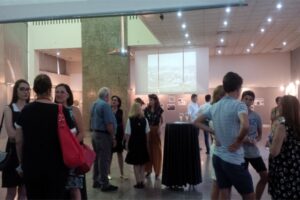The photographer who escaped Communist regime
This exhibition brings together 12 prominent Dutch photographers, documenting the period before and during various revolutions in the former Eastern Bloc countries. They witnessed historical moments, such as the emergence of the Polish trade union Solidarnosc in Gdansk in 1980, the fall of the Berlin Wall, and the Romanian revolution of 1989. Yet, they also captured ordinary everyday life.

But how did the photos from the Albanian communist period end up in the hands of this group of Dutch journalists? This is somehow a dangerous and funny story at the same time. Everyone knows Albania was one of the most closed countries in Europe until 1992. It was more difficult to travel in Albania than in North Korea. The only way to visit the country is to be part of a group of tourists led by an Albanian guide. In May 1987, one of these tourists was the photojournalist Piet den Blanken. He understood that visiting this isolated country is rare, so he decided to document as many images as possible from Albania. During the day, he followed the official group program. But in the early morning and late in the day, he escaped from the group to take photographs everywhere he could. In this way, he tried to get another image of the country, an image that was not shown to the world. It was not easy for him. Police arrested him, but they found no film in his camera, just a white empty camera. The truth is that he gave his full shot of films to one of the members of the tourist group before the police doubted him. Johan Janse was the person who hid the material in his luggage, and the films went out of the country. Thanks to him, we have some unique photos of Albanians during the communist period.


Visit Tirana interviewed Ad Nuis, the curator of this exhibition, also from the Netherlands, who was present at the opening ceremony in Tirana, among other personalities. He said that he knew and met Piet den Blanken – the courageous photographer- who still lives in the Netherlands, but now an old man prefers to stay behind the scenes. Ad Nuis said that Western people are more interested in what happened in the East during the Cold War. This is the explanation of why they find these old things and documents about communism very interesting, while it is not the same with people who suffered under the communist regime. The interest of Albanians in the past is just awakening. After 25 years, we think that the past is over, and we have to talk freely about that to know what happened and to teach this part of history to new generations. Opening of some museums, such as Bunkart or House of Leaves, shows that Albanians have no more fear of the past.
Ad Nuis said Albania is the second stop of this Exhibition, after the first one, Poland. They will continue to exhibit these photos in some other countries to show the rare images of life under dictators during the Cold War.
Other News to Read
Alessandro from Italy: My unforgettable experience in Tirana
As for the city of Tirana, it was truly stunning and filled with surprises.